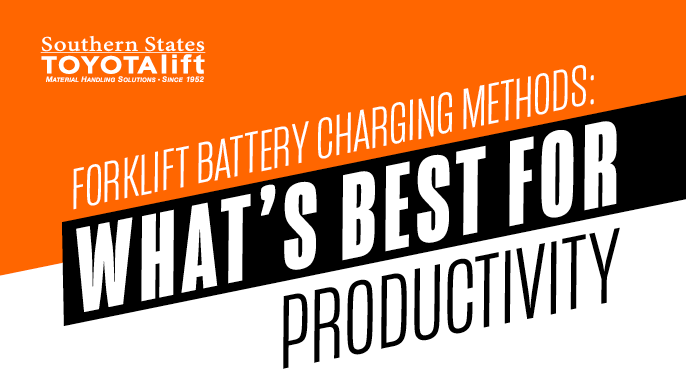
Whether you’re replacing your existing forklift batteries or charging equipment, there are three main charging options for you to choose from, namely:
- Conventional
- Opportunity
- Fast-charging
While it may seem like a small choice, making the right decision now can help you save thousands or maybe even hundreds of thousands of dollars over time.
Let’s take a look at each one to see which is right for your business.
Conventional Charging
As you likely already know, the biggest difference between each of these options is the way in which the batteries are charged. Conventional charging is the simplest and, consequently, has the lowest infrastructure cost.
To charge conventionally, all it takes is eight hours of continuous charging followed by a required eight-hour cooldown period.
This makes them ideal for single-shift operations. Your teams can run the forklift until the battery is around 20% and then, over the course of an evening, charge it to 100% state of charge (SOC). The eight-hour cooldown period can be satisfied the following day.
One often overlooked aspect of charging forklift batteries is that it must be done in a well-ventilated area in order to keep hydrogen levels below OSHA’s limits.
As far as drawbacks are concerned, the first point to make is that they’re not ideal for multiple shifts or trying to run forklifts continually. While it could be done by way of purchasing multiple batteries and having clear-cut procedures on the who, how, and when of switching them out, this could potentially slow down productivity.
Opportunity Charging
Running a two-shift operation? Then maybe opportunity charging is the best option for you.
Opportunity charging is done during short periods of time in which the battery is not being used. This can include during breaks or in between shifts.
To maximize productivity and manage the amount of heat generated from charging, opportunity charging stations shut off once the battery is around 80%-85% SOC. Once a week, the battery must be charged to a full 100%.
Opportunity charging stations are most effective when placed near employee break areas so that your team members can remember to use their break time (or lunch or shift switch time) to opportunity charge. This means that your warehouse will need to have the space necessary to install forklift charging stations in the optimal location and the infrastructure budget to make that possible.
However, under the right conditions, opportunity charging batteries can save you money by eliminating battery change out equipment, the need to buy additional batteries, and time spent switching them out.
Fast-Charging
Fast-charging is great for multi-shift and 24/7 operations, the trade-off is infrastructure cost.
As the name suggests, the charge rate is significantly faster and the lift is charged more frequently throughout the day. The battery can be short charged during breaks or in-between shifts which would eliminate extra batteries and battery changing equipment.
Fast charge batteries are setup to provide the maximum amount of charge during the period while minimizing temperatures. Most fast charge batteries are equipped with a battery monitoring device which regulates heat by communicating with the charger.
They are also normally equipped with dual intercell connectors and cables due to the high amperage output. Fast charging also only charges to 85%-90% SOC on a daily basis which reduces the amount of gasses emitted from the battery. And, like opportunity charging, it must be charged to 100% at least once a week.
Although fast-charging batteries are the highest in upfront cost, they can wind up saving companies a significant amount of money by reducing downtime and keeping operations running smoothly.
Conventional vs Opportunity vs Fast-charging - Which is Best for Your Business?
This guide only briefly touched upon the key aspects of each type of battery. If you’re still unsure of which is the right one for your business, we are more than happy to help. Contact us online, by phone at (866) 529-6953, or in person at one of our eleven locations. We can help you understand each option more in-depth or even schedule a consultation based on your needs.
FLORIDA
Jacksonville
Lakeland
Ocala
Orlando
Tampa
Winter Haven
GEORGIA
Albany
Macon
Columbus
Valdosta
Further Reading:
Switch to Electric Forklifts: See How Much You’ll Save
Get the Most Out of Your Forklift: Battery Care 101
Why You Should Choose OEM Parts For Your Toyota Forklifts
